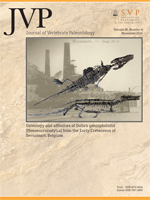A fossil egg clutch from the Pleistocene of Lord Howe Island, Australia that we assign to Testudoolithus lordhowensis, oosp. nov. belongs to the stem turtle Meiolania platyceps. This ootaxon is diagnosed by the following unique combination of characters: large spherical eggs (53.9 mm diameter), 800-µm-thick eggshell, and barrel-shaped shell units with height-to-width ratio of 1.2:1. Thin sections and scanning electron microscopy demonstrate that these eggs are composed of radiating acicular aragonite crystals. This mineral composition first evolved either before the split between Meiolaniformes and crown Testudines or prior to Proterochersis robusta, the earliest known stem turtle. A calculated gas conductance of 170.27 mg H2O day-1 Torr-1 for Meiolania platyceps eggs compares closely with that of two extant tortoise eggs. This value and the presence of at least two superimposing egg layers within the clutch indicate that Meiolania platyceps deposited its eggs inside an excavated hole nest. This nesting strategy likely evolved no later than the Early to Middle Jurassic.
How to translate text using browser tools
1 November 2016
A Fossil Egg Clutch from the Stem Turtle Meiolania platyceps: Implications for the Evolution of Turtle Reproductive Biology
Daniel R. Lawver,
Frankie D. Jackson
ACCESS THE FULL ARTICLE





